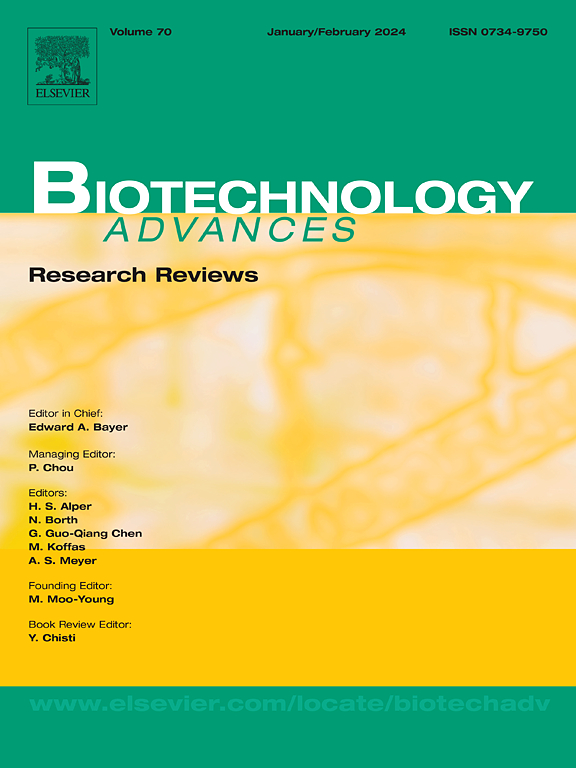Multigene engineering in plants: Technologies, applications, and future prospects
IF 12.5
1区 工程技术
Q1 BIOTECHNOLOGY & APPLIED MICROBIOLOGY
引用次数: 0
Abstract
The emerging bioeconomy presents a promising solution to both economic and environmental challenges. Within the bioeconomy, plants serve as a renewable, sustainable, and cost-effective source of foods, fuels, chemicals, and materials. However, traditional breeding and single-gene engineering approaches fall short in addressing complex traits (e.g., drought tolerance, disease resistance, yield, nutrient use efficiency) which are controlled by multiple genes. The complexity of plant biology often necessitates the use of multigene engineering (MGE), which involves simultaneous ectopic expression, up/down-regulation, or editing of multiple genes, to enhance plant traits relevant to the bioeconomy. These genes may be associated with distinct traits or function as components of specific metabolic and regulatory pathways. This review summarizes current technologies for MGE within the synthetic biology-driven Design-Build-Test-Learn (DBTL) framework, detailing its four key stages: Design – gene construct development; Build – DNA assembly and plant transformation; Test – the molecular, biochemical, and physiological characterization of engineered plants; and Learn – computational modeling to refine, multiplex and iterate the process. Despite good progress in the applications of MGE in biofortification, metabolic engineering, and stress resilience, challenges remain in construct stability, coordinated gene expression, and regulatory predictability. We identified optimization paths and future directions to accelerate MGE deployment in sustainable agriculture, with possible societal benefits including reduced production costs, increased yield, and improved food and nutritional security.
植物多基因工程:技术、应用及未来展望。
新兴的生物经济为经济和环境挑战提供了一个有希望的解决方案。在生物经济中,植物是一种可再生的、可持续的、具有成本效益的食物、燃料、化学品和材料来源。然而,传统的育种和单基因工程方法在处理由多个基因控制的复杂性状(如耐旱性、抗病性、产量、养分利用效率)方面存在不足。植物生物学的复杂性往往需要使用多基因工程(MGE),包括同时异位表达,上调/下调或编辑多个基因,以增强与生物经济相关的植物性状。这些基因可能与不同的性状有关,或作为特定代谢和调节途径的组成部分发挥作用。本文综述了合成生物学驱动的设计-构建-测试-学习(DBTL)框架下MGE技术的现状,详细介绍了其四个关键阶段:设计-基因构建开发;构建- DNA组装与植物转化;测试-工程植物的分子、生化和生理特性;学习计算建模来细化、复用和迭代过程。尽管MGE在生物强化、代谢工程和应激恢复方面的应用取得了良好进展,但在构建稳定性、基因协调表达和调控可预测性方面仍存在挑战。我们确定了优化路径和未来方向,以加速MGE在可持续农业中的应用,可能带来的社会效益包括降低生产成本、提高产量、改善粮食和营养安全。
本文章由计算机程序翻译,如有差异,请以英文原文为准。
求助全文
约1分钟内获得全文
求助全文
来源期刊

Biotechnology advances
工程技术-生物工程与应用微生物
CiteScore
25.50
自引率
2.50%
发文量
167
审稿时长
37 days
期刊介绍:
Biotechnology Advances is a comprehensive review journal that covers all aspects of the multidisciplinary field of biotechnology. The journal focuses on biotechnology principles and their applications in various industries, agriculture, medicine, environmental concerns, and regulatory issues. It publishes authoritative articles that highlight current developments and future trends in the field of biotechnology. The journal invites submissions of manuscripts that are relevant and appropriate. It targets a wide audience, including scientists, engineers, students, instructors, researchers, practitioners, managers, governments, and other stakeholders in the field. Additionally, special issues are published based on selected presentations from recent relevant conferences in collaboration with the organizations hosting those conferences.
 求助内容:
求助内容: 应助结果提醒方式:
应助结果提醒方式:


